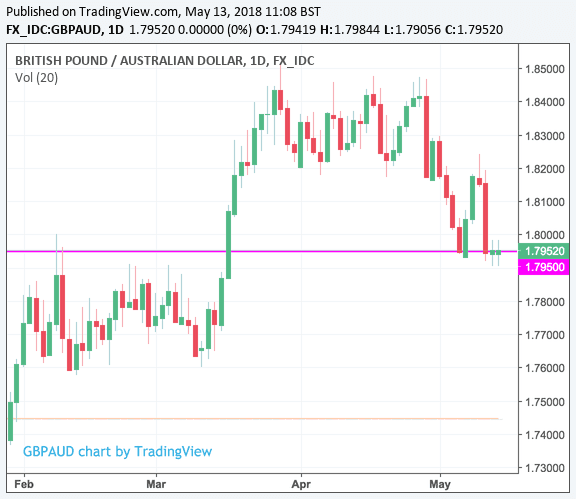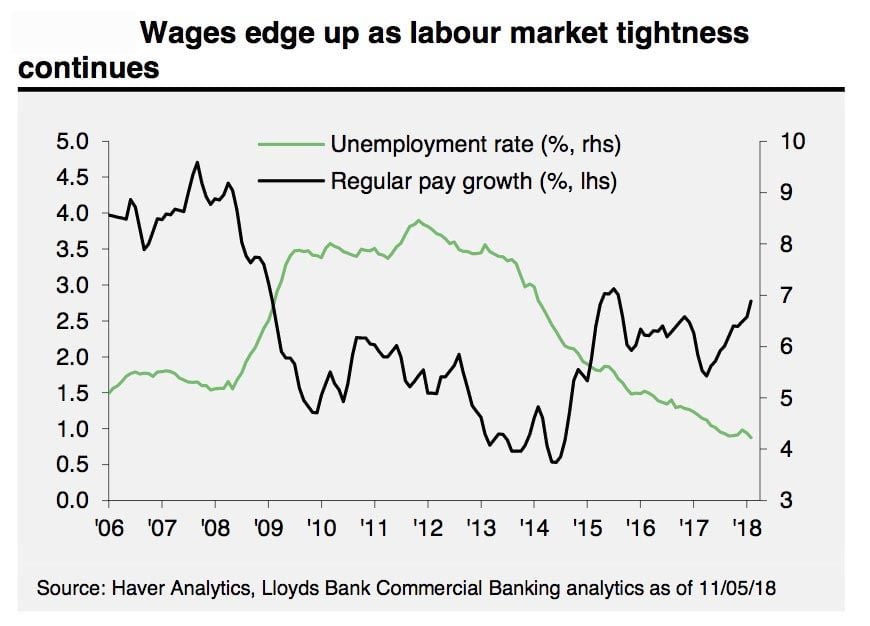Pound-Australian Dollar Rate Week Ahead Forecast: Wages, Wages, Wages
- Momentum is to the downside for GBP/AUD
- Wage and employment out of the UK could however boost Sterling in the week ahead
- Key wage data out of Australia dominates the calendar for AUD exchange rates
The Pound-to-Australian Dollar exchange rate's long-term period of recovery came to an end in late March, and after a multi-week period of consolidation the pair has declined back to 1.80.
To us, near-term momentum appears to favour the Australian Dollar, and as such we will be looking for a break of support at 1.7950 for confirmation of further losses in GBP/AUD.
Indeed, the exchange rate opens the week at 1.7952 and the first half of the week could be instructive from this regard.

But, beware there are two significant wage data releases out of both Australia and the United Kingdom in the week ahead, and this could well shake the market and is a reason we are not going to rely on technical indicators too heavily at this point.
Advertisement
Get up to 5% more foreign exchange by using a specialist provider to get closer to the real market rate and avoid the gaping spreads charged by your bank when providing currency. Learn more here.
AUD: What to Watch
Tuesday, May 15:
The minutes from the Reserve Bank of Australia's May 1 meeting are released, key here is guidance on expectations for economic growth and foreign exchange markets will pore over the subtleties of the minutes, looking for changes in language and emphasis from the previous meeting. We don't foresee any surprises, but those watching AUD need to be wary of surprises around this time.
Wednesday, May 16:
What is certainly likely to provoke more interest is the release of Australian wage numbers for the first quarter - much of the RBA's policy stance with regards to future interest rate moves relies on wage dynamics with the general rule-of-thumb being that accelerating wages should prompt an earlier interest rate rise, and disappointing wage numbers should delay the move.
Markets are looking for the quarterly wage index to read at 0.5%, a miss would likely hurt AUD, a beat would likely boost AUD.
Thursday, May 16:
With wage data fresh in the market's memory, eyes turn to Aussie employment numbers with expectations for a boost to employment of 20K while the unemployment rate is forecast to remain at 5.5% and the participation rate at 65.7%.
Disappointment in the above will likely weigh on the currency as it suggests future wage dynamics will remain disappointing, and recall much of the RBA's policy stance is based on expectations for wages.
"Crucially, there will be updates on wages and employment. We have argued for a while now that in the current environment the wages data is just as important as the CPI for monetary policy. That is largely because monetary policy won’t be tightened until wages growth is on a sustained upward trend even if CPI inflation rise," says Gareth Aird, an economist with Commonwealth Bank Australia, who warns that they see risks that the wage data will disappoint.
GBP: What to Watch
Data is back to the forefront for Pound Sterling now that markets are trading the currency on expectations for future interest rate moves at the Bank of England. Indeed, we saw Sterling come under pressure on Thursday May 10 after the Bank chose not to raise interest rates at their May policy event, despite clear signals over preceeding months that they were likely to do so.
What we do know is that the Bank will only deliver a Sterling-supportive interest rate rise should UK data show signs of a strong recovery from a soft start to the year, and this week's data releases will therefore be key.
Tuesday May 15
Foreign exchange markets will be eyeing labour market statistics for March and April at 09:30 AM B.S.T.
The claimant count for April is forecast to have risen to 7.5K from 11.6K previously, while the unemployment rate is forecast to stay unchanged at 4.2% in March.
The three-month-on-three-month change in employment will be key, but we are yet to see market forecasts for the outcome.
Analysts at Lloyds Bank Commercial Banking are looking for a rise in employment of 150K, saying "the employment gain for the three months to March will provide a measure of the underlying strength of the economy." A rise if 150K "would be a substantive increase for the quarter, consistent with the view that the slowdown in output was most likely temporary."
For Sterling the most important release of the day is however likely to be the wage data - the average earnings index + bonus for March is forecast to have registered growth of 2.6%, down from the previous month's 2.8%.
Should wages beat expectations we would expect Sterling to rally as it suggests there is a real risk of domestically-generated inflationary pressures rising in coming months. Such an observation would likely steer the Bank of England's hand towards delivering an interest rate rise in August.
At 10:00 AM Mark Carney and some of his lieutenants will be under the spotlight when they are questioned by the Treasury Select Committee in Westminster on their current guidance for interest rates and expectations for the UK economy.
Expect some criticism from MPs on the apparent u-turn performed by the Bank of England when they opted to not raise rates in May, despite having dropped some significant hints that such an outcome was likely over preceding months.
The Bank will no doubt point at the data. What could move markets is any strong hint on future rate prospects for the economy, so keep an eye on the newswires.
"The market now assigns a greater-than-even chance that the MPC will be on hold for the rest of the year. We are not so sure, because we look for GDP growth to rebound in coming quarters. We acknowledge the downside risks that Brexit uncertainty imparts to the economic outlook, but we still forecast that the MPC will raise rates 25 bps at the August 2 policy meeting. After that rate hike, we then look for the MPC to remain on hold through the end of the year," say analyst at global investment bank Wells Fargo in their latest assessment on the future of UK interest rates.
Advertisement
Get up to 5% more foreign exchange by using a specialist provider to get closer to the real market rate and avoid the gaping spreads charged by your bank when providing currency. Learn more here.





